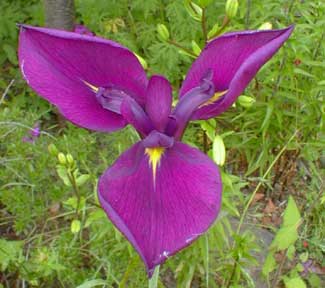
Japanese Water Iris;
aka Russian Iris
"Some pious poet, enemy of sleep,
Takes in his hollow hand the tear of snow
Whence gleams of iris & of opal start,
And hides it from the Sun, deep in his heart."
-Charles Baudelaire
(1821-1867)
(1821-1867)
Iris ensata (formerly I. lactea & I. kaempferi or Japanese Water Iris is a pond-margin iris requiring persistent moisture. It is native not only to Japan but is very widespread in China, Korea, India & eastern Russia.
A boggy garfden is best. But we planted one in the open garden in a spot near the White Icicle Currant which gets watered very regularly but is certainly never boggy, & like most water irises it adapts perfectly well far from any water margin, just so long as life isn't actually droughty.
When dormant they cannot be in boggy conditions, as they are adapted to habitat that dries out in winter & is flooded in spring. If they are kept as marginals in the pond, they will need to be displayed in submerged pots that can be removed & allowed to sit well-drained for winter, which does not mean bone dry.
It will produce larger flowers & spread more vigorously if partially submerged at least in spring, & as long as from spring to early autumn, with its root crown as much as six inches deep, then removed from boggy conditions by September. But if grown in the open garden, they can be left in place year-round & may even succeed as evergreens, though usually the grass gets so scruffy by some point in autumn it should be cut back to within six inches of the ground. WIthout the seasonal flooding it will spread more slowly but will otherwise do splendidly with only moderate moisture.
It can start to bloom at any time from May to July, later than most irises. Ours produced its first bloom at the tail-end of its third spring in the garden, in June.
THis wild form has three standards & three small falls, but there are fancier cultivars with the falls greatly enlarged so that they seem to have six standards. I'm enamored of the simpler wild form, but they're all obviously gorgeous.
Its extremely slender bud was present a couple weeks earlier in May, & having forgotten what was planted there we had no idea what it was going to be until it actually bloomed on a four-foot stalk above three-foot grass.
It wants full sun & deplores shade, though a tiny bit of shade probably won't keep it from flowering well. In deeper shade it would do horribly. It is also rather allergic to alkalinity & if lime gets on it while liming the lawn, the irises will decline.
The species name ensata means "sword-like" though I find it more grass-like & the even tougher evergreen Gladwyn iris is more certainly sword-like. The leaves have been used in India & China for a fibre similar to hemp.
THis wild form is grown in Japan to harvest the roots for an edible starch, even though, if improperly prepared, the root is toxic. The fancier cultivars are mainly ornamental, & this species is the iris longest in cultivation throughout Asia, though relatively recent to western cutlivation (the last century mainly).
Although it has not seemed to be as prone to troublesome invasiveness in the manner of the Yellow Iris, it's widespread presence throughout Asia suggests it could someday get a similar foothold in temperate North America. In Vermont & a couple other Eastern states, I. ensata has already escaped to invade watersheds. It is propogated by division & by offsets, which can be done either in March or October, its rhizomes divided & replanted one to three inches deep. If it is in a bog setting & not apt to be heat-stressed or the least bit dry, it can be divided early summer shortly after it finishes blooming.
As it spreads it may require division as often as every three years, but might also be left for many more years before it crowds itself so much that blooms decline.
Color varieties & named cultivars don't grow true from seeds, so propogation is only by offsets & division of rhizome, but ours is the wild form & was seed-grown. It would grow true from seed. The wild form has smaller flowers than do named varieties (which have the largest blooms of any iris in the world, up to eight inches across), but even the wild form provides a good-sized bloom.